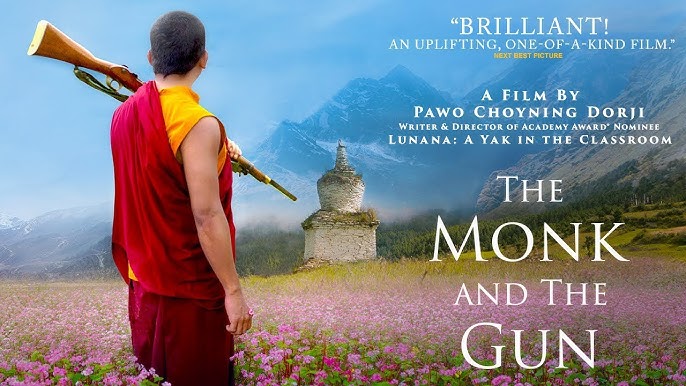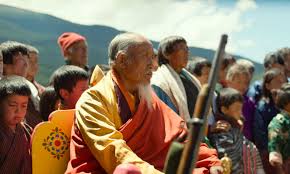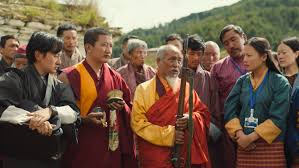🎬 The Monk and the Gun (2023)

The Monk and the Gun (2023) Movie Review: A Satirical Exploration of Bhutan’s Transition to Democracy
The Monk and the Gun (2023), directed by Pawo Choyning Dorji, offers a unique and insightful look into Bhutan’s transition from an absolute monarchy to a democratic nation. Known for his Academy Award-nominated film Lunana: A Yak in the Classroom, Dorji’s latest work blends humor and poignant social commentary to tell a story that not only explores Bhutan’s political transformation but also the clash between traditional Buddhist values and the influence of Western modernity.
Set against the backdrop of Bhutan’s first democratic elections in 2006, The Monk and the Gun invites audiences into a world where cultural preservation, political change, and the tension between East and West collide. The film’s heartwarming yet satirical approach makes it a standout in Bhutanese cinema, offering both entertainment and profound reflections on the nature of governance, happiness, and societal evolution.
Plot Overview: A Journey of Tradition and Change
The Monk and the Gun follows the story of a young monk tasked with an unusual mission: he must acquire a firearm for his Lama, a spiritual leader. This seemingly straightforward quest soon evolves into a journey that takes him into the heart of Bhutan’s political and cultural shift as the country navigates the complexities of modern democracy.
In the process, the monk encounters a variety of characters, most notably an American tourist, whose arrival marks a turning point in the young monk’s life. The clash between the monk’s deeply rooted Buddhist values and the encroaching influence of Western ideals becomes central to the narrative. As the monk’s mission unfolds, the film moves through a series of comedic yet poignant events, highlighting the larger cultural tensions facing Bhutan during this critical time in its history.
Themes: Modernization, Cultural Preservation, and Western Influence
At its core, The Monk and the Gun is a film about the balance between modernization and cultural preservation. Bhutan, known for its unique concept of Gross National Happiness (GNH), offers a different perspective on governance, one that is rooted in Buddhist philosophy rather than the Western ideals of democracy and material progress.
The film humorously critiques the Westernization of Bhutan, highlighting the contradictions that arise when foreign ideals attempt to supersede local traditions. The monk’s quest for a weapon, in a nation that has long been resistant to conflict and violence, symbolically represents the tensions between preserving a peaceful, traditional lifestyle and adapting to the pressures of modernity. The arrival of the American tourist further underscores the theme of globalization and how foreign influences can challenge and reshape traditional cultures.
Another key theme explored in the film is the impact of democracy. Bhutan’s peaceful transition to a constitutional monarchy and its adoption of democratic elections are central to the narrative. Through the monk’s experiences and interactions, The Monk and the Gun subtly critiques the idea that Western-style democracy is universally applicable. The film suggests that Bhutan’s own unique approach to happiness, community well-being, and governance might offer valuable lessons to other nations grappling with similar issues.
Character Dynamics: The Monk, the Lama, and the American Tourist
The character of the young monk is crucial to the film’s exploration of tradition versus change. He is not just a vessel for the plot; he represents Bhutan’s younger generation, caught between preserving their cultural identity and navigating the rapidly changing world around them. His character’s evolution is both humorous and touching, as he grapples with his mission and his beliefs, growing into someone who begins to understand the complexities of the world he lives in.
The Lama, whose request sets the events in motion, embodies the deep-rooted spiritual traditions of Bhutan. However, his role also raises questions about the intersection of religion and politics, especially as Bhutan makes its transition to democracy. The Lama’s insistence on acquiring a weapon feels paradoxical in a country that prides itself on peace, adding depth to the exploration of how traditional values can sometimes clash with the needs of a changing society.
The American tourist, who represents the external, Western influence, plays a pivotal role in the story. His presence disrupts the monk’s familiar world, symbolizing the intrusion of Western ideals into Bhutan’s carefully guarded way of life. Through his interactions with the monk and other characters, the tourist serves as both a catalyst for change and a symbol of the Western world’s impact on non-Western societies.
Cinematography and Direction: A Stunning Visual Experience
The cinematography in The Monk and the Gun is nothing short of breathtaking. Bhutan’s stunning landscapes, with their serene mountains and lush valleys, form the perfect backdrop for the story’s themes of tradition and change. The film uses its environment not just as a setting, but as a character in itself, symbolizing the tension between Bhutan’s past and its future.
Pawo Choyning Dorji’s direction is masterful, blending satire with sincerity. The pacing is deliberate, allowing the audience to fully immerse themselves in the world of Bhutanese culture and the monk’s journey. Dorji’s careful handling of both comedic and dramatic moments adds layers to the film, ensuring that the humor never detracts from the film’s deeper message. The film’s satirical elements are lighthearted, but they never lose sight of the serious issues it raises, making it both entertaining and thought-provoking.
Critical Reception: A Film that Engages and Inspires
The Monk and the Gun has garnered positive reviews from critics and audiences alike. On Rotten Tomatoes, the film holds a Certified Fresh status, with the critics’ consensus praising its ability to “surround poignant insights with a gentle layer of crowd-pleasing comedy.” The balance between humor and drama is one of the film’s standout features, and it has been praised for delivering a message about Bhutan’s societal evolution in a way that is both accessible and emotionally resonant.
Roger Ebert’s website calls the film “a true crowd-pleaser,” noting that it successfully captures both the humor and depth of Bhutan’s cultural and political changes. The film’s nuanced storytelling has earned it critical acclaim, with many pointing out its ability to tackle heavy themes while still being an enjoyable and engaging experience.
At the 2023 Rome Film Festival, The Monk and the Gun was awarded the Special Jury Prize, highlighting its international appeal and the recognition of its unique perspective on political and cultural change.
Conclusion: A Unique and Heartfelt Film
The Monk and the Gun is an extraordinary film that invites viewers into the heart of Bhutan’s societal transformation. Through its satirical exploration of Western influence and its critique of the imposition of democracy, the film offers a thoughtful commentary on modernization and cultural preservation. By blending humor with serious reflections on the intersection of tradition and modernity, The Monk and the Gun creates a captivating cinematic experience that resonates with audiences worldwide.
Whether you’re interested in films that explore political change, cultural identity, or the impact of globalization, The Monk and the Gun offers a rich and engaging narrative that will leave you reflecting on the balance between the past and the future.
⭐ Final Rating: 9